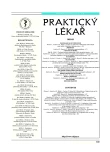Occurrence of drug interactions in clients of the Škoda Employee Insurance Co.
Výskyt lékových interakcí u klientů Zaměstnanecké pojišťovny Škoda
V této práci bylo sledováno riziko lékových interakcí (LI), kterému byli vystaveni pojištěnci Zaměstnanecké pojišťovny Škoda (ZPŠ). Sledování proběhlo nad databází uhrazených receptů ZPŠ, do které byly zařazeny recepty realizované od 1. 7. 2001 do 30. 6. 2004. Bylo zjištěno, že 1 promile receptů je vystaveno na lék, který s již předepsaným lékem dává vzniknout velmi závažné LI. Velmi závažnou LI bylo každé pololetí ohroženo průměrně 343 pojištěnců ZPŠ, což je 0,39 procent všech pojištěnců, kterým byl v daném období předepsán lék na recept. Z velmi závažných LI byly nejčastěji zjišťovány interakce warfarinu, statinů, léků prodlužujících interval QT a antidepresiv. Léky interagující s již zavedenou terapií byly předepisovány v ambulancích nemocnic, ambulantními specialisty i praktickými lékaři. Ve shodě se zahraničními prameny autoři doporučují, aby lékaři byli o LI vyskytujících se v jejich preskripci informováni a cíleně školeni tak, aby riziko ohrožení pacienta bylo minimalizováno.
Klíčová slova:
lékové interakce – kvalita zdravotní péče – Zdravotní pojišťovna Škoda – rozbory preskripce.
Authors:
M. Prokeš; Z. Vitásek; J. Suchopár; J. Kolář; H. Simonová; J. Buršík; R. Mach
Published in:
Prakt. Lék. 2005; 85(8): 457-460
Category:
Therapy
Overview
There has been followed up the risk of drug interactions (DI) which the insured at the Škoda Employee Insurance Co. (SEI) had been exposed to. The follow-up was carried out in the data base of prescriptions (July 1, 2001 – June 30, 2004) settled by the SEI. It has been found that 1 š of the prescriptions had been prescribed for a drug that posed a serious DI with one that had been already prescribed previously. At an average, 243 insured at the SEI were threatened by a serious DI within a period of six months, that being 0.39% of all insured that were prescribed a remedy over the given period. Of the very serious DI the most frequently encountered were interactions of warfarin, statins, drugs prolonging the QT interval, and antidepressants. Drugs interacting with already introduced therapy had been prescribed at out-patient wards of hospitals, by out-patient specialists, and by general practitioners. In agreement with sources abroad the authors recommend that physicians be informed of the DI occurring in their prescriptions and be speciafically trained so that the risk of threat to the patient be minimized.
Key words:
drug interactions – quality of healthcare – Škoda Employee Insurance Co. – prescription analyses
Labels
General practitioner for children and adolescents General practitioner for adultsArticle was published in
General Practitioner

2005 Issue 8
- Memantine Eases Daily Life for Patients and Caregivers
- Metamizole at a Glance and in Practice – Effective Non-Opioid Analgesic for All Ages
- Metamizole vs. Tramadol in Postoperative Analgesia
- Memantine in Dementia Therapy – Current Findings and Possible Future Applications
- What Effect Can Be Expected from Limosilactobacillus reuteri in Mucositis and Peri-Implantitis?
Most read in this issue
- Bacterial immunomodulators
- Antibiotics and their application in pregnancy
- Diagnosis and therapy of tracheal stenosis
- Type A aortic dissection, case reports
